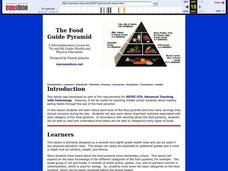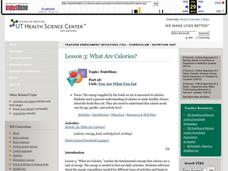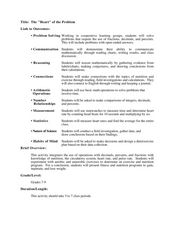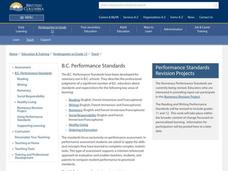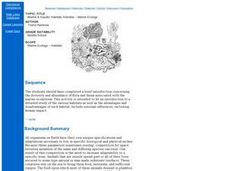Curated OER
Your 4-H Focus on Food Labels
Facilitate healthy eating habits with this collection of activities. This worksheet, made for 4-H originally, covers nutrition, health, and fitness. Middle schoolers focus on the life skill of making healthy lifestyle choices. They...
Curated OER
Making Healthy Food Choices
In this well-designed nutritional activity, students are given the opportunity to create their own daily food record, compare their nutrient with minimimun requirements, and think critically about their own food choices. Materials and...
EduGAINs
Making Savvy Consumer Choices
It's never too early to learn about grocery budgeting. Middle schoolers delve into the world of consumer math with a lesson that focuses on both healthy choices and real-world math applications. Groups work together to form a grocery...
Curated OER
The Food Guide Pyramid
Students examine each level of the food pyramid and how many servings they should consume during the day. They study the important nutrients associated with each category of the food pyramid.
Media Smarts
Packaging Tricks
As part of their study of how advertisers use various techniques to influence consumers, kids examine the design, the promotions, and the product placement in the packaging of their favorite foods.
Curated OER
Food Math
Pupils brainstorm healthy food choices. In this health science lesson, students calculate how much of each food group they need daily. They plan a menu based on the "MyPyramid for Kids" food guide.
Curated OER
Food Math
Fourth graders explore healthy habits by completing caloric measurement activities. In this food choice lesson plan, 4th graders discuss what types of foods give you protein or fat and utilize a food chart to measure caloric intake....
Curated OER
Counting on Good Health
First graders engage in fun activities in order to understand the food pyramid and how to make healthy nutritional choices. The lesson is used in order to help students make healthy lifestyle choices.
Curated OER
Food Needs, Food Wants
Students explore wants and needs. In this family budgeting lesson, students play the Food Money game to help them distinguish between food wants and needs. Students discuss their impressions of the game and food budgets.
Curated OER
My Pyramid
Students complete a graphing activity to learn about fruits and vegetables as well as their nutritional qualities. In this fruits and vegetables instructional activity, students complete a series of activities that help teach them about...
Curated OER
Pick a Better Snack and Act
Students make healthy choices. For this healthy living mini-unit, students make healthy lifestyle choices through hands-on activities, songs and movement. This mini-unit includes lessons on the food pyramid, fruits, vegetable, and...
Curated OER
Making a Difference in World Health
Students discover environmental awareness by conducting a collection project in class. In this global food instructional activity, students identify the importance of feeding all of the humans on Earth and discuss why some aren't...
Curated OER
Shopping-Unit Pricing
Comparing unit prices of food products is a skill that learners will use for the rest of their lives. Here is a simple plan that provides practice calculating the unit price for various grocery store products. Use two jars with differing...
Curated OER
Advanced Algebra: Do You Feel Lucky?
Young scholars explore the realm of mathematical probability while playing a game of chance. after constructing paper rockets, they fire it enough times to determine the probabilities of the rocket traveling past a marked distance and...
Kenan Fellows
How Does an Unhealthy Diet Influence our Health and Well-Being?
You are what you eat, or so they say! After surveying family and friends on a week of eating habits, learners analyze the data for patterns. They compare different variables such as fats and cost, fats and calories, or fats and LDLs.
Curated OER
Healthy Snacks. Healthy Packaging
Fourth graders research how to select the most cost-effective snacks. In this consumer practices lesson plan, 4th graders compare packaging labels and come to conclusions on how cost effective the product is. Students discuss their...
Curated OER
What Are Calories?
Students examine calories for the human body. In this calorie instructional activity, students explore the energy expenditures needed for different types of activities and how many calories are needed to support daily functions.
Lincoln Public Schools
Cereal Box Project
Challenge your class with this fun and engaging engineering design project. The goal, to create a brand new cereal complete with a list of ingredients, a name and logo, and a box to hold it in. Starting with a survey to determine the...
Curated OER
The "Heart" of the Problem
Students create an exercise and nutrition program. In this interdisciplinary lesson, students use calculations of exercises plus their corresponding effects on the body and nutritional values of food to derive a health plan. Students...
Curated OER
What's My BMI?
Students construct the Metric Pyramid from the handout. They use the Metric Pyramid to convert from standard to metric measure and vice versa. They compute their own Body Mass Index.
Curated OER
Children's Health: Children Aren't Little Adults
This instructional activity is a compilation of interdisciplinary, technology-infused activities that focus on the often complicated and sometimes controversial issues related to toxic chemicals in children's environment. Special...
Curated OER
Childhood Obesity
Students identify a question to generate appropriate data and predict results. They distinguish between a total population and a sample and use a variety of methods to collect and record data. Students create classifications and ranges...
Curated OER
Nutrition Lesson Plan
Second graders complete a survey as class answering the question: "Did you eat breakfast this morning?". They place a tally mark in the column that best represents their answer. They then discuss the results in the graph.
Curated OER
Marine & Aquatic Habitats Activities - Marine Ecology
Students enact the life cycle of a sessile animal and quantify the possibility of survival under the conditions given. They then present to the class a new adaptation which will increase the animals chance of survival.





